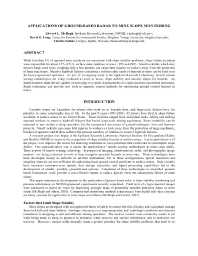Mining Publication: Applications of Ground-Based Radar to Mine Slope Monitoring
Original creation date: May 2004
While less than 1% of reported mine accidents are associated with slope stability problems, slope failure accidents were responsible for about 15% of U.S. surface mine fatalities between 1995 and 2003. Small rockfalls, which may involve hand-sized rocks weighing only a few pounds, can cause fatal injuries to workers away from the protection of large machinery. Massive highwall failures containing a million cubic yards of material or more can be fatal even for heavy-equipment operators. As part of an ongoing study at the Spokane Research Laboratory, several remote sensing technologies are being evaluated as tools to assess slope stability and monitor slopes for hazards. An interferometric radar device capable of detecting very small displacements on slopes has been assembled and tested. Radar techniques can provide new tools to augment current methods for monitoring ground control hazards in mines.
Authors: EL McHugh, DG Long, C Sabine
Conference Paper - May 2004
Presentation at annual conference of American Society for Photogrammetry and Remote Sensing, Denver, May 23-28, 2004; :12 pp
See Also
- Advances in Remote Sensing Techniques for Monitoring Rock Falls and Slope Failures
- Analysis of Bench Crest Performance at the Yellowstone Mine: A Case Study
- Applications of Ground-Based Radar to Mine Slope Monitoring
- Applications of the Point Estimation Method for Stochastic Rock Slope Engineering
- Assessing and Monitoring Open Pit Mine Highwalls
- Current Research on Slope Movement in Mines: Use of Hyperspectral Imagery
- Detecting Problems With Mine Slope Stability
- Evaluating Techniques for Monitoring Rock Falls and Slope Stability
- Slope Stability
- A User's Guide for the Bplane, Bstepp, and Bwedge Computer Programs
- Page last reviewed: 9/21/2012
- Page last updated: 9/21/2012
- Content source: National Institute for Occupational Safety and Health, Mining Program


 ShareCompartir
ShareCompartir
